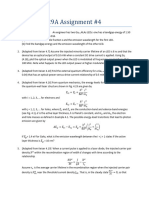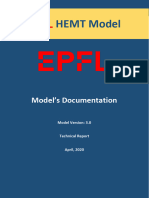Antenna Sh4
Antenna Sh4
Uploaded by
refaatCopyright:
Available Formats
Antenna Sh4
Antenna Sh4
Uploaded by
refaatCopyright
Available Formats
Share this document
Did you find this document useful?
Is this content inappropriate?
Copyright:
Available Formats
Antenna Sh4
Antenna Sh4
Uploaded by
refaatCopyright:
Available Formats
ECE4225 FOURTH LEVEL SHEET 4 03/26/2019
1. An infinitesimal electric dipole is centered at the origin and lies on the x-y plane
along a line which is at an angle of 45o with respect to the x-axis. Find the far-
zone electric and magnetic fields radiated. The answer should be a function of
spherical coordinates.
𝜋 𝐼0 𝑙 2
2. Derive the radiated power of 𝑃𝑟𝑎𝑑 = 𝜂 | | by forming the average power
3 𝜆
density, using the following formulas and integrating it over a sphere of radius r
𝑘𝐼 𝑙𝑒 −𝑗𝑘𝑟
𝐸𝜃 ≃ 𝑗𝜂 0 sin 𝜃
4𝜋𝑟
𝐸𝑟 ≃ 𝐸𝜑 = 𝐻𝑟 = 𝐻𝜃 = 0 𝑘𝑟 ≫ 1
𝑘𝐼0 𝑙𝑒 −𝑗𝑘𝑟
𝐻𝜑 ≃ 𝑗𝜂 sin 𝜃
4𝜋𝑟 }
3. Derive the far-zone fields of an infinitesimal electric dipole, of length L and
𝑙
𝜇𝐼0 −𝑗𝑘𝑟 𝜇𝐼 𝑙
∫ 𝑙 𝑑𝑧 ′ = 𝑎̂𝑧 4𝜋𝑟 𝑒 −𝑗𝑘𝑟 and
0
constant current I0, using 𝐴(𝑥, 𝑦, 𝑧) = 𝑎̂𝑧 𝑒 2
4𝜋𝑟 −
2
𝑎̂𝑟
the procedure outlined in 𝐸𝐴 ≃ −𝑗𝜔𝑨 , 𝐻𝐴 ≃ x 𝐸𝐴 Compare the results with
𝜂
the formulas mentioned in problem 2.
4. The current distribution on a terminated and matched long linear (traveling
wave) antenna of length l, positioned along the z-axis and fed at its one end, is
′
given by 𝐼 = 𝑎̂𝑧 𝐼0 𝑒 −𝑗𝑘𝑧 , 0 ≤ 𝑧 ′ ≤ 𝑙 where I0 is a constant. Derive expressions
for the
a. Far-zone spherical electric and magnetic field components.
b. Radiation power density.
5. A line source of infinite length and constant current I0 is positioned along the
z-axis. Find the
a. Vector potential A.
b. Cylindrical E- and H-field components radiated.
∞ 2 +𝑡 2
𝑒 −𝑗𝛽√𝑏
Hint: ∫ 𝑑𝑡 = −𝑗𝜋𝐻𝑜 (2) (𝛽𝑏)
√𝑏 2 + 𝑡2
−∞
Where H0(2)(αx) is the Hankel function of the second kind of order zero.
ECE4225 FOURTH LEVEL SHEET 4 ASSOCCIATE PROF. TAMER ABOUELNAGA
You might also like
- Theory of Reflectance and Emittance Spectroscopy (PDFDrive)Document529 pagesTheory of Reflectance and Emittance Spectroscopy (PDFDrive)Shashikant SinghNo ratings yet
- Magnetic Field: 1-Biot-Savart LawDocument8 pagesMagnetic Field: 1-Biot-Savart Lawmark markNo ratings yet
- Chapter 28 Sources of Magnetic Field: Stationary Charge Electric FieldDocument54 pagesChapter 28 Sources of Magnetic Field: Stationary Charge Electric FieldGenna NgNo ratings yet
- Fields and Wave BasicsDocument5 pagesFields and Wave BasicsLola OmowaNo ratings yet
- L13 ConductorDocument8 pagesL13 ConductorBobNo ratings yet
- Magnetic InductionDocument20 pagesMagnetic Inductionsutapadey276No ratings yet
- Problems Set 1Document2 pagesProblems Set 1inyourareab789No ratings yet
- Clase Act ElectroMagCirc Linearsys RotMachineDocument9 pagesClase Act ElectroMagCirc Linearsys RotMachinesfasdfNo ratings yet
- 1.electrical Charges and FieldsDocument45 pages1.electrical Charges and FieldsOnetap solutionsNo ratings yet
- Engineering Electromagnetics Hayt Chap 3 SolutionDocument18 pagesEngineering Electromagnetics Hayt Chap 3 Solutionseominwook22111No ratings yet
- Sp401i TD1Document2 pagesSp401i TD1Liam AbourousseNo ratings yet
- Applied Physics: Electronic Engineering Department Anjum KhairiDocument26 pagesApplied Physics: Electronic Engineering Department Anjum KhairiHussain CommunicationNo ratings yet
- Unit 8 NotesDocument14 pagesUnit 8 NotesEdward William ElgarNo ratings yet
- XkjijjnnDocument11 pagesXkjijjnnmohit bhardwajNo ratings yet
- 12th Boards Derivations BC!Document62 pages12th Boards Derivations BC!Sparsh-9th EN- 31No ratings yet
- PP For CH 23Document32 pagesPP For CH 23allah rakha swabiNo ratings yet
- ELCN323 EM Field_Week_9_Lecture_8Document26 pagesELCN323 EM Field_Week_9_Lecture_8Áĥmêđ Ã Žĩđäñ (احمد زيدان)No ratings yet
- Practice Exam 1a (Solutions)Document5 pagesPractice Exam 1a (Solutions)frazierNo ratings yet
- QUESTIONS ParticlePhysics2019Document8 pagesQUESTIONS ParticlePhysics2019Sagar RawalNo ratings yet
- Gauss's Law and Electrostatic Potential EP 5Document91 pagesGauss's Law and Electrostatic Potential EP 5Gurvansh SinghNo ratings yet
- 4 - Microwave Components CourseDocument85 pages4 - Microwave Components CoursedaekmmmmNo ratings yet
- IOSR 2019 YanvarDocument6 pagesIOSR 2019 YanvarShahla Ganbar IlkinNo ratings yet
- Cheat Sheet - ElectromagnetismDocument26 pagesCheat Sheet - Electromagnetismu2100128No ratings yet
- Medina (193253920) Problemset7 V1Document6 pagesMedina (193253920) Problemset7 V1shaunmedina0006No ratings yet
- Interactive Lecture 1 Topic 1Document22 pagesInteractive Lecture 1 Topic 1AbdulJawad Ibrahim ElmezoghiNo ratings yet
- Lecture06 ch23 2Document11 pagesLecture06 ch23 2gmy101700No ratings yet
- Unit-Iii Magnetic Effect of Current: Oersted 'S ExperimentDocument12 pagesUnit-Iii Magnetic Effect of Current: Oersted 'S ExperimentparveezNo ratings yet
- Name: Sajeel Khan Roll#:M.phil-SSP-03-F19 Class: M.phil SSP (Morning) Subject: Optical Properties of Solid Submitted TODocument8 pagesName: Sajeel Khan Roll#:M.phil-SSP-03-F19 Class: M.phil SSP (Morning) Subject: Optical Properties of Solid Submitted TOAnonymous f7wV1lQKRNo ratings yet
- Lec 13 Semiconductors 4Document16 pagesLec 13 Semiconductors 4Mayur JambhulkarNo ratings yet
- 10 PP Ynm Phy103 2021 IiDocument2 pages10 PP Ynm Phy103 2021 IiRAJ MEENANo ratings yet
- Low Pass & High Pass Pi Section Filter Lab ManualDocument17 pagesLow Pass & High Pass Pi Section Filter Lab ManualRiya MaityNo ratings yet
- PHM 601 Question Bank-2018Document4 pagesPHM 601 Question Bank-2018Abhishek YadavNo ratings yet
- Key Words: Ampere's Law, Field Due To Solenoid, Current Sheet,. ProblemsDocument19 pagesKey Words: Ampere's Law, Field Due To Solenoid, Current Sheet,. ProblemsKarla delarosaNo ratings yet
- Test6 v0Document8 pagesTest6 v0Marcus PoonNo ratings yet
- Steady State Magnetic Field-Part2Document18 pagesSteady State Magnetic Field-Part2alexanderoliver5010No ratings yet
- PP Tapes of Resistance in AC CircuitsDocument21 pagesPP Tapes of Resistance in AC CircuitsAlin CoversNo ratings yet
- Electrical ConductivityDocument3 pagesElectrical ConductivitySambhavi MishraNo ratings yet
- Diffraction PPT 2021Document36 pagesDiffraction PPT 2021shreyas chawareNo ratings yet
- Physical Optics: 18 March 2021Document37 pagesPhysical Optics: 18 March 2021Luo MarkNo ratings yet
- Magnetic Fields: What You Should Know!!!!Document10 pagesMagnetic Fields: What You Should Know!!!!angelNo ratings yet
- Displacement Surface CartesianDocument3 pagesDisplacement Surface CartesianPaul CNo ratings yet
- 12 FormulaDocument15 pages12 Formulagkgthe1No ratings yet
- Tutorial OneDocument5 pagesTutorial Onelearnmachinelearning24No ratings yet
- Antenna Lect5Document14 pagesAntenna Lect5fadwaalhaderee100% (2)
- ECE452 529A Assignment 4Document2 pagesECE452 529A Assignment 4Uche NwogboNo ratings yet
- Magnetostatic FieldDocument7 pagesMagnetostatic Fieldpsnp meNo ratings yet
- CH1 Electric Charges & Fields (Notes)Document8 pagesCH1 Electric Charges & Fields (Notes)ryantharakan123No ratings yet
- Lecture 15Document5 pagesLecture 15JOSE CARLOS LEON GONZALEZNo ratings yet
- EC2105 - Lecture - 9 Magnetic Field 1Document28 pagesEC2105 - Lecture - 9 Magnetic Field 1hyunyoung256No ratings yet
- Additional Exercises: (Chapter - 1) (Electric Charges and Fields)Document14 pagesAdditional Exercises: (Chapter - 1) (Electric Charges and Fields)HARSHITNo ratings yet
- I Just Want To Download 1 PDFDocument4 pagesI Just Want To Download 1 PDFSachika ValenlieNo ratings yet
- Epfl Hemtv3.0.0Document36 pagesEpfl Hemtv3.0.0Shanthini SridharNo ratings yet
- Chem5302 Lecture10Document14 pagesChem5302 Lecture10hrkongoloNo ratings yet
- Medical Physics 8Document19 pagesMedical Physics 8hasnalhrakeNo ratings yet
- Linear Wire Antennas: EE-4382/5306 - Antenna EngineeringDocument24 pagesLinear Wire Antennas: EE-4382/5306 - Antenna EngineeringJose Nathaniel BonaNo ratings yet
- Week 9Document17 pagesWeek 9sesu4840No ratings yet
- Emtl Unit-IiDocument18 pagesEmtl Unit-IiBck SreedharNo ratings yet
- Chapter 7 Magnetostatic Fields EDITEDDocument40 pagesChapter 7 Magnetostatic Fields EDITEDMarc Rivera100% (2)
- Problems in Quantum Mechanics: Third EditionFrom EverandProblems in Quantum Mechanics: Third EditionRating: 3 out of 5 stars3/5 (2)
- Mathematical Analysis 1: theory and solved exercisesFrom EverandMathematical Analysis 1: theory and solved exercisesRating: 5 out of 5 stars5/5 (1)
- Microwave Sh4Document1 pageMicrowave Sh4refaatNo ratings yet
- Antenna Sh5Document1 pageAntenna Sh5refaatNo ratings yet
- Ece4225 Fourth Level Sheet 2 03/05/2019Document2 pagesEce4225 Fourth Level Sheet 2 03/05/2019refaatNo ratings yet
- Antenna Sh3Document1 pageAntenna Sh3refaatNo ratings yet
- Electric Dipole and Its Behavior Under Electric FieldDocument16 pagesElectric Dipole and Its Behavior Under Electric FieldsNo ratings yet
- L14 20 UnlockedDocument100 pagesL14 20 UnlockedSabbir BejoyNo ratings yet
- PS Electrostatics AGNI Phy Akash Gupta Sir Satish Sharma CombinedDocument32 pagesPS Electrostatics AGNI Phy Akash Gupta Sir Satish Sharma Combinedagjayesh008.sesNo ratings yet
- 12 - Physics Question Paper (Pre-Board Ii)Document7 pages12 - Physics Question Paper (Pre-Board Ii)VaniceWhilderNo ratings yet
- PhysicsDocument3 pagesPhysicsRDX CoffinNo ratings yet
- STD Xii Physics - Complete NotesDocument218 pagesSTD Xii Physics - Complete NotesOM KAILASHNo ratings yet
- Electricity & MagnetismDocument12 pagesElectricity & MagnetismM HASIN ISHMAM JEETNo ratings yet
- Electric Charges & Fields DPP 7Document3 pagesElectric Charges & Fields DPP 7kijetNo ratings yet
- PhysicsDocument63 pagesPhysicsprisha4No ratings yet
- Chap 20Document18 pagesChap 202tlfdlNo ratings yet
- Electric Charges and Fields l4 Physics Class 12 Cbse by Ashu SirDocument15 pagesElectric Charges and Fields l4 Physics Class 12 Cbse by Ashu Sirvedantu495No ratings yet
- DielectricsDocument47 pagesDielectricsVaishnavi BhadrashetteNo ratings yet
- 8 Text Sol Paper 1 CATS AFST 6 7-5-23 AnanthGarg&on Trak0EduCompetishunDocument26 pages8 Text Sol Paper 1 CATS AFST 6 7-5-23 AnanthGarg&on Trak0EduCompetishunneet04281No ratings yet
- Beginners: Very Short Answer Questions (1 Marks)Document21 pagesBeginners: Very Short Answer Questions (1 Marks)kapil sharmaNo ratings yet
- FACULTY OF ENGINEERING (Batch 1) - CLICK HERE TO BDocument1 pageFACULTY OF ENGINEERING (Batch 1) - CLICK HERE TO BCaleb OnaopemipoNo ratings yet
- Electric Charge & Electric Field: Chapter 21 of Young & Freedman'sDocument68 pagesElectric Charge & Electric Field: Chapter 21 of Young & Freedman'sFranztoni Jerard Nicer Juan100% (2)
- Em AllDocument62 pagesEm AllДаркоNo ratings yet
- Tarea 2Document10 pagesTarea 2Felipe López GarduzaNo ratings yet
- Dipole and Torque On A DipoleDocument40 pagesDipole and Torque On A Dipoleanusuya.mishra1975No ratings yet
- Electro Statics Worksheet CbseDocument19 pagesElectro Statics Worksheet CbseAmanNo ratings yet
- Electric Charges and Fields Test Ch1Document8 pagesElectric Charges and Fields Test Ch1amy868762No ratings yet
- Worktext in Electromagnetism For Teachers 1 Physics 1Document10 pagesWorktext in Electromagnetism For Teachers 1 Physics 1Alice C. RiveraNo ratings yet
- Ans Key 12 JammuDocument14 pagesAns Key 12 JammuVAIBHAW VAIBHAWNo ratings yet
- Electric Properties of Materials: Project PHYSNET Physics Bldg. Michigan State University East Lansing, MIDocument30 pagesElectric Properties of Materials: Project PHYSNET Physics Bldg. Michigan State University East Lansing, MIEpic WinNo ratings yet
- Ch. 5 Conductor and DielectricDocument40 pagesCh. 5 Conductor and DielectricMade AndikaNo ratings yet
- Anuja PhysicsDocument9 pagesAnuja PhysicsHridya UllasNo ratings yet
- +2 Holidays HW-PhysicsDocument9 pages+2 Holidays HW-PhysicsNav JotNo ratings yet



























































































